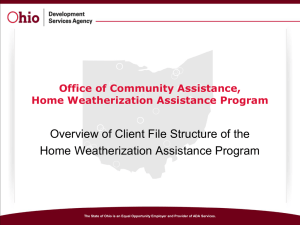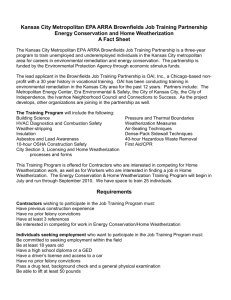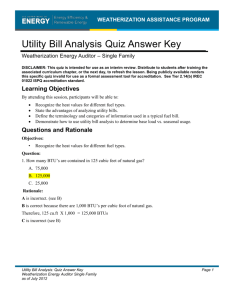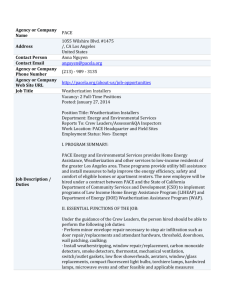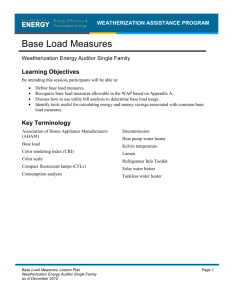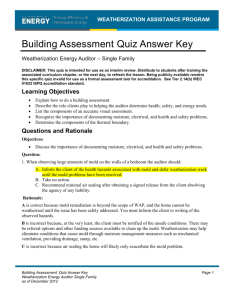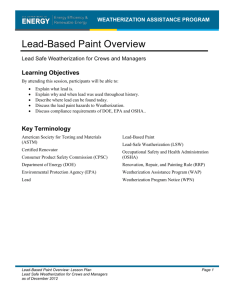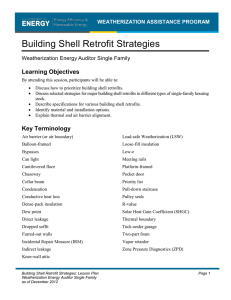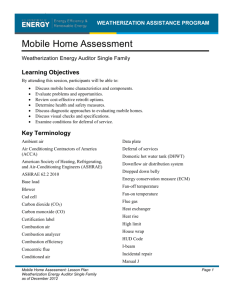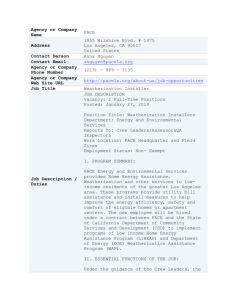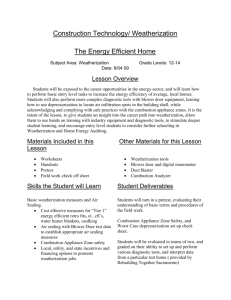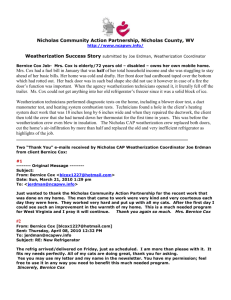Building Assessment - Weatherization Assistance Program
advertisement
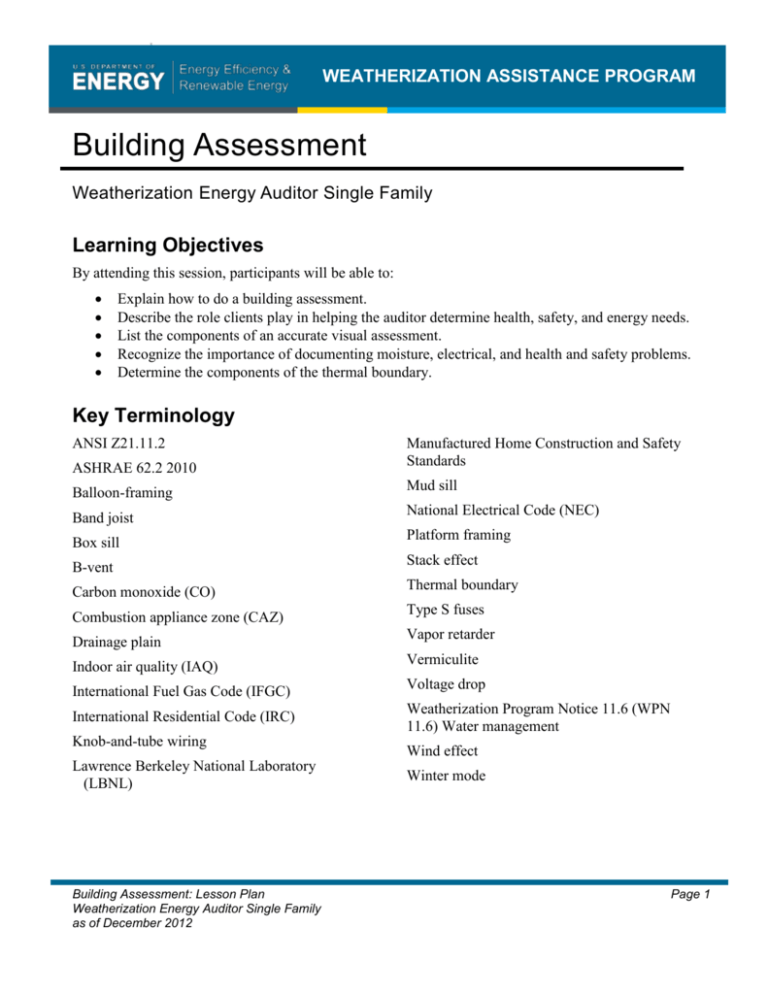
WEATHERIZATION ASSISTANCE PROGRAM Building Assessment Weatherization Energy Auditor Single Family Learning Objectives By attending this session, participants will be able to: Explain how to do a building assessment. Describe the role clients play in helping the auditor determine health, safety, and energy needs. List the components of an accurate visual assessment. Recognize the importance of documenting moisture, electrical, and health and safety problems. Determine the components of the thermal boundary. Key Terminology ANSI Z21.11.2 ASHRAE 62.2 2010 Manufactured Home Construction and Safety Standards Balloon-framing Mud sill Band joist National Electrical Code (NEC) Box sill Platform framing B-vent Stack effect Carbon monoxide (CO) Thermal boundary Combustion appliance zone (CAZ) Type S fuses Drainage plain Vapor retarder Indoor air quality (IAQ) Vermiculite International Fuel Gas Code (IFGC) Voltage drop International Residential Code (IRC) Weatherization Program Notice 11.6 (WPN 11.6) Water management Knob-and-tube wiring Lawrence Berkeley National Laboratory (LBNL) Building Assessment: Lesson Plan Weatherization Energy Auditor Single Family as of December 2012 Wind effect Winter mode Page 1 WEATHERIZATION ASSISTANCE PROGRAM Supplemental Materials Handouts & Resources Aleshire, Vic. “Crawlspace Solutions.” Home Energy May/June 2004: 27-29. <www.homeenergy.org.> Armanda, Larry. “Voltage Drop and Test Equipment.” WTC Technical Update 1.4 (Mar. 2004). Weatherization Training Center at Pennsylvania College of Technology. <www.pct.edu/wtc/docs/articles/Voltage_Drop&Test_Equipment.pdf.> “Auditing: The Challenge of the Site Visit.” WxTV. Montana Weatherization Training Center. <www.wxtvonline.org>. Bohac, David. “Zone Pressure Diagnostics.” Home Energy May/June 2002: 32-37. <www.homeenergy.org.> Building Assessment Quiz. Building Assessment Quiz Answer Key. Hales, David. “The SCARY Crawlspace.” Home Energy 5 Jan. 2011. <www.homeenergy.org>. “Introduction and the Evaluation Process.” Weatherization Tech Exchange. Energy Center of Wisconsin. <www.ecw.org>. Khawaja, M. Sami and Patricia Koss. “Building Better Weatherization Programs.” Home Energy Mar./Apr. 2007. <www.homeenergy.org.> La Rue, Jim. “A Conditioned Crawlspace Checklist.” Home Energy May/June 2004: 24-26. <www.homeenergy.org.> Moriarta, Courtney. “Fixing Air Leaks in Connecticut Town Houses.” Home Energy Jul./Aug. 2008. <www.homeenergy.org.> National Fire Protection Agency. "Table 13.1: Type B Double-Wall Gas Ventilation Table" from the NFPA54: National Fuel Gas Code. <www.nfpa.org>. The Energy Conservatory. "Minneapolis Blower Door: Operation Manual for Model 3 and Model 4 Systems." The Energy Conservatory. May 2004. <www.energyconservatory.org>. The Energy Conservatory. "Operating Instructions for the DG-700 Pressure and Flow Gauge." The Energy Conservatory. Jan. 2007. <www.energyconservatory.org>. Turk, Brad. “Crawlspaces, Considering the Options.” Home Energy May/June 2004: 30-33. <www.homeenergy.org.> U.S. Department of Energy. Weatherization Assistance Program. “WPN 11-6 Health & Safety Guidance.” 12 Jan 2011 <www.waptac.org>. Page 2 Building Assessment: Lesson Plan Weatherization Energy Auditor Single Family as of December 2012 WEATHERIZATION ASSISTANCE PROGRAM Van der Meer, Bill. “Air Leakage in Recessed Lighting.” Builder Brief (BB0502). Undated. Pennsylvania Housing Research Center, Penn State University. <www.engr.psu.edu/phrc.> Van der Meer, Bill. “Avoiding Moisture Problems.” WTC Technical Update 1.1 (Feb. 2003). Weatherization Training Center at Pennsylvania College of Technology. <www.pct.edu/wtc/docs/articles/WTC-Tech-Update-Moisture.pdf.> Online Platform Lessons Use these online interactive training modules as prerequisites before students attend the course or as in-class computer lab sessions. To access the lesson, users must first create an account at www.nterlearning.org. a- 2.0 Visual Assessment https://www.nterlearning.org/web/guest/course-details?cid=248 a- 2.1 Exterior Walkaround https://www.nterlearning.org/web/guest/course-details?cid=248 a- 2.2 Interior Walkaround https://www.nterlearning.org/web/guest/course-details?cid=248 a- 2.3 Attic Assessment https://www.nterlearning.org/web/guest/course-details?cid=248 a- 2.4 Basement/Crawlspace Assessment https://www.nterlearning.org/web/guest/course-details?cid=248 a- 2.7 Building Measurements https://www.nterlearning.org/web/guest/course-details?cid=248 a- 5.1 Evaluating Attic Insulation https://www.nterlearning.org/web/guest/course-details?cid=248 c- 5.1 Understanding Effective R-Value https://www.nterlearning.org/web/guest/course-details?cid=247 i- 3.4 Building Envelope, Thermal Envelope, Pressure Boundary & Conditioned Space https://www.nterlearning.org/web/guest/course-details?cid=249 Relevant Standard Work Specifications 1.202 – Unvented Space Heaters 1.402 – Drainage 1.601 – Knob & Tube Wiring 4.1001.1 – General Preparation, Non-Insulation Contact (IC) Recessed Light 4.1001.2 – General Preparation, Knob & Tube Wiring 4.1001.3 – General Preparation, Fireplace Chimney and Combustion Flue Vents 4.1006 – Attic Openings 4.1088.1 – Special Considerations, Attic Ventilation 4.1101.1 – Preparation, Exterior Wall Dense Packing 5.3003.4 – Equipment Maintenance, Testing and Repair, Evaluating Electrical Service Building Assessment: Lesson Plan Weatherization Energy Auditor Single Family as of December 2012 Page 3 WEATHERIZATION ASSISTANCE PROGRAM Classroom Props & Activities House Footprint and Elevation Sketches - Break the class into groups to create a house sketch showing dimensions, window placement, floor plan, elevations, etc. Simple Area Calculation – Give students worksheets and calculators to work privately. Then work the problem out on the white board to make sure everyone understands perimeter, area, and volume area measurements. Refer to the section titled “Math Skills” in the Auditor module for more resources. Electrical Circuit Analysis – Demonstrate the electrical circuit analyzer by plugging it into an outlet on an electrical circuit, which may be affected if insulation comes into contact with the circuit. Measure the voltage drop. A difference above 5% may indicate an unsafe condition. Hands-On Field Activities If possible, take the class to a real home to conduct a full building assessment. An in-field visit can serve as an alternative to or supplement breakout sessions in a lab. Find a homeowner who is willing to have an energy audit performed by a group of no more than 10 to 12 students under the direction of a knowledgeable instructor. The house should be a typical single-family home with an operating forced-air furnace, an attic, and a basement or crawl space. Other features such as an attached garage or additions are desirable. Plan to spend 2 to 3 hours in the home to conduct a visual assessment and diagnostic tests. Provide students with flashlights, measuring tapes, and clipboards with paper and pencils. Plan to take digital pictures. Allow students to disperse into small groups and come together periodically to assess their progress, discuss findings, or watch and take part in activities such as blower door testing or zonal pressure diagnostics. After the field visit, reassemble in the classroom and let the students share their observations. The instructor should facilitate a discussion of the relative importance of each piece of data and how that data will ultimately fit into a fully documented building assessment. Show the pictures taken at the house site to enhance the discussion of specific features observed at the home. Break the class into groups to create a house sketch showing the floor plan of the basement, living space, and attic. Have each group designate one person to create the drawing with others providing input on the content. All three drawings should contain basic information obtained at the site such as exterior dimensions and shape. The basement drawing should show features such as the location of the heating system, hot water tank, exterior and interior doors, air leakage sites, etc. The living space should show the relative location of windows, doors, additions, and other special features. The attic space should highlight vent locations, the attic hatch, knee-wall attics, leakage sites, attic staircase, etc. Allow approximately 30 minutes for this activity. Then ask the groups to turn in their sketches. Take a few moments to examine them and offer feedback or additional information on the white board. Page 4 Building Assessment: Lesson Plan Weatherization Energy Auditor Single Family as of December 2012 WEATHERIZATION ASSISTANCE PROGRAM Class Overview Deliver the PowerPoint presentation to students. Note sample questions in the speaker notes located in selected slides. These will provide opportunity for class participation. Focus on a systematic approach and what kinds of things they should be looking for when conducting a building assessment. Introduce students to the key elements of a complete building assessment, including: Client interview. Physical characteristics and dimensions. Insulation levels. Health and safety. Electrical. Use the presentation to introduce the concept of air and thermal boundaries, reinforcing what’s inside and what’s outside. Building Assessment: Lesson Plan Weatherization Energy Auditor Single Family as of December 2012 Page 5
